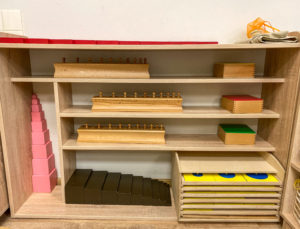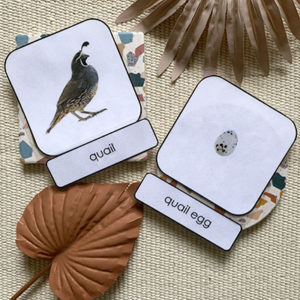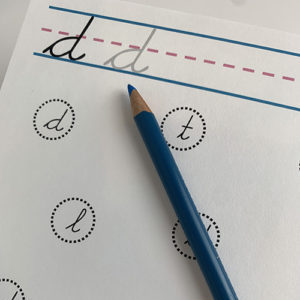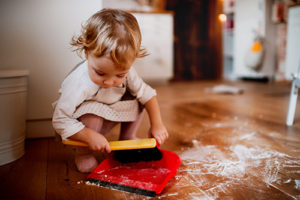The Montessori moveable alphabet is such a simple and effective teaching tool, I’m shocked it is not used in every classroom – Montessori or not! But like many of Montessori’s ideas they have remained hidden for decades until people realize the genius!
What is the Montessori Moveable Alphabet?
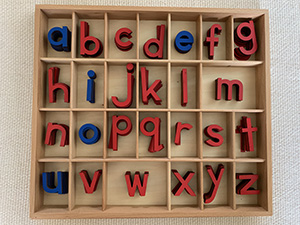
The moveable alphabet is a wooden box containing 26 separate compartments for the letters of the alphabet, with vowels in blue and consonants in red. (You can sometimes find the reverse color scheme, which may be preferable.) There are several forms it can take, from oversized letters that map to the sandpaper letters, to small wooden letters {affiliate link} or double-sided cards with upper and lowercase letters on either side. The letters are used to teaching spelling, reading, and writing, without the difficulty of needing to write by hand.
In sequence of the overall Montessori language progression, the moveable alphabet should be introduced after a child has had plenty of practice with phonemic awareness activities as well as tracing letter forms with the sandpaper letters.
Why is the Moveable Alphabet so important?
The main reason the moveable alphabet is so important is because it separates the skill of spelling from the skill of writing. As a result, a child can develop their cognitive skills of spelling to develop at its own pace, which is often faster than their motor skills of writing! This dramatically reduces frustration for both tasks, since some children struggle with writing even if they know how to spell.
The moveable alphabet allows the children to express themselves with the written word. Children can place letters in order, creating words, sentences, and even stories. This is a crucial step in the more abstract skills needed for reading: having a word, thought, or idea in your mind, and using knowledge of sounds and symbols to put it into a physical form that anyone can see, understand, or interpret.
When to use the Moveable Alphabet
Using the moveable alphabet itself is easy. The most important thing is knowing when to introduce the moveable alphabet to a child. Too soon and the child may get discouraged. Some children are aware of the moveable alphabet because they see older children working with it.
Make sure the child has had a lot of practice with sound awareness activities first. Make sure the know at least 4-5 sandpaper letter forms and sounds very solidly before introducing the moveable alphabet. They child doesn’t need to know every letter. They just need to know enough to get started with a few simple consonant-vowel-consonant, or CVC, words.
There are 3 main moveable alphabet lessons a child will begin with:
- Introduction to the Moveable Alphabet
This lesson is simply orienting the child to the material itself. It can be somewhat overwhelming the first time a child sees this box full of letters. You will want to show them how we take a letter out and put it back into the box it came from. Just this alone can be a challenge.- Invite the child to the rug for a new presentation. Let them know, enthusiastically, that they are ready for the moveable alphabet! They should get the feeling this is something special.
- Ask if they know where it is. Lead them to the shelf, point out the material, and name it. Demonstrate slowly and carefully carrying the tray in the middle and not to let it tip as the letter can get mixed, or worse, fall out! You may even want to say, “I carry the box in the middle so it doesn’t tip.”
- Show the child how to place the tray on the rug, lift the lid and place it under the tray in the upper left corner of the rug. (This reinforces the top-down, left-to-right order for reading.)
- During their first introduction, take out a letter you think they may know, such as a letter in their first name. Take the letter out. Then demonstrate how you find the correct compartment to put it back into. You may want to demonstrate stacking the letters neatly as a challenge. You can ask, “Would you like a turn to take a letter and put it back?” They can do this with individual letters. This is the end of the first presentation.
- Matching Sandpaper letters to moveable alphabet letters.
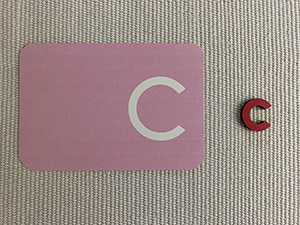
Dr. Montessori describes the “passage to abstraction” that each child must go through – and being able to know that the letter b on a sandpaper letter and the letter b in the form of a small wooden letter is the same symbol and sound is an important step to the abstract activity of reading. From then on a child should know any time they see a letter symbol, it represents a particular sound.- Begin this lesson by bringing a set of sandpaper letters and the moveable alphabet to a rug in two separate trips. Feel free to reintroduce the material and how we carry it, if needed. Some children are ready to retrieve the work on their own, others may still need help. Use your best judgment.
- Tell the child today they will match sandpaper letters, which are big, to moveable alphabet letters, which are small. Alternatively if you have the large moveable alphabet letters that map to the sandpaper letters you can use those.
- Start with familiar letters they have had plenty of practice with. Trace the sandpaper letter and then find the moveable alphabet letter that matches moving from left to right, top to bottom. “This says [letter sound] and this says [letter sound]. One is bigger, one is smaller, and they say the same sound.”
- Note: although we do not emphasize letter names, if the child has difficulty finding the letters and they know the “Alphabet Song” you can show them how to name each letter and find the letter they need. I made a TikTok video with over 80K views many people found helpful.
- Using the moveable alphabet to spell simple words.
- The next presentation, tell the child you will spell a word. If you have language objects or images such as my Moveable Alphabet CVC Word cards,
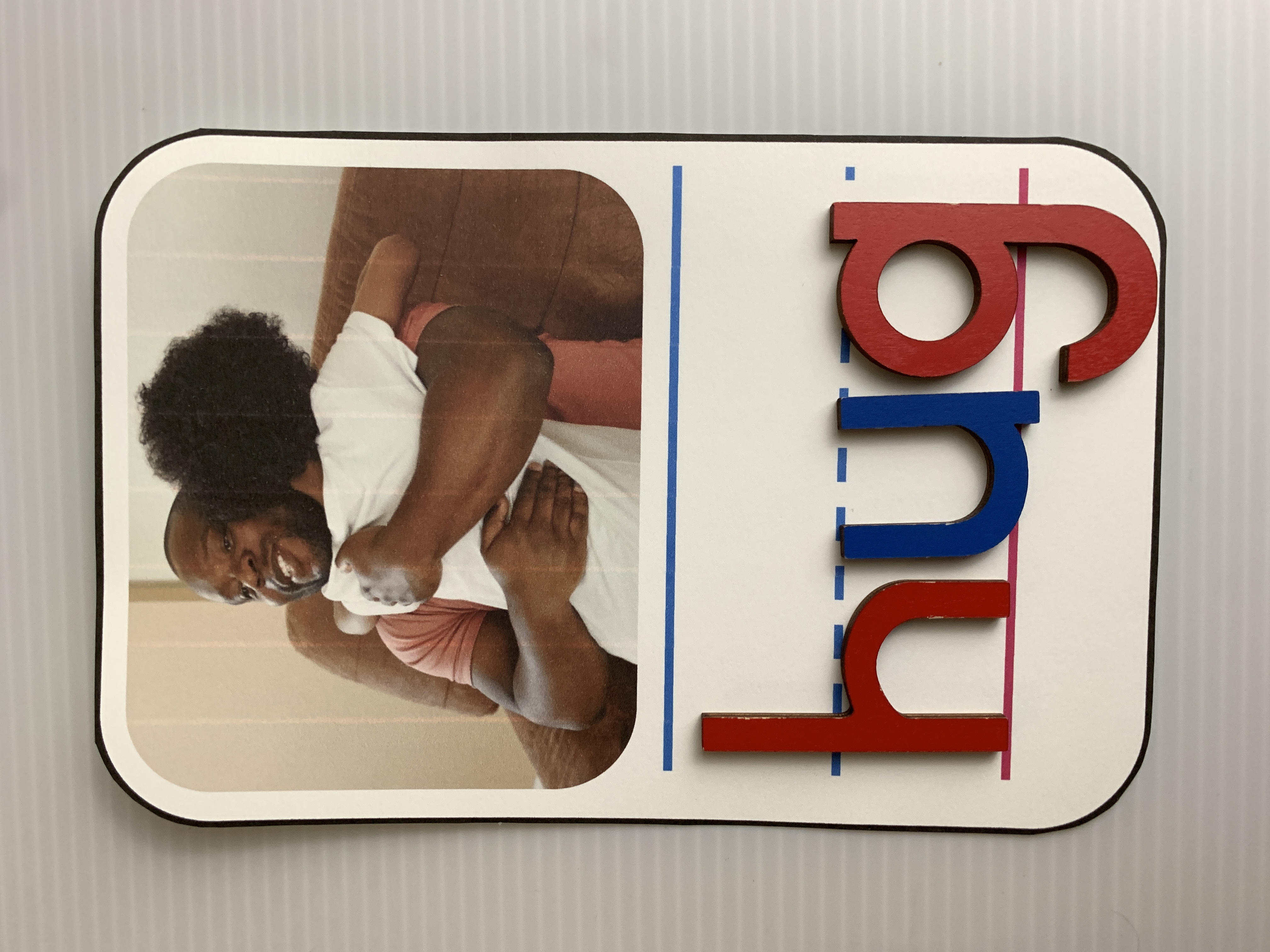 you can use them.
you can use them.
- Use objects or images with letters you know the child has practiced and can recognize, such as “cat.” Ask the child, “What sound does “cat” begin with?” If they produce the correct sound, ask, “Can you find the [c] in this tray?” It may take time for them to locate the letters.
- Proceed through each letter sound, or phoneme, to find the letter shape, or grapheme. Note: the moveable alphabet can be used for phoneme grapheme mapping activities as well. If you want to know more about orthographic mapping, please read this comprehensive post by Little Elephant Teacher.
- Continue until this word is spelled and introduce 2-3 more words as long as the child isn’t showing signs of fatigue. Provide just as much support as the child needs – do not rush to provide answers and help unless the child seems frustrated or struggling.
- The next presentation, tell the child you will spell a word. If you have language objects or images such as my Moveable Alphabet CVC Word cards,
I hope you can see how useful the moveable alphabet is! Once the child is ready to write letters by hand, the moveable alphabet can be used to practice spelling words, sentences, and stories, and then the child can rewrite by hand to create a booklet or journal.
Do you have any questions about using the moveable alphabet? Email me!
Media error: Format(s) not supported or source(s) not found
Download File: https://joyofmontessori.com/wp-content/uploads/2022/02/examples-of-phoneme-segmentation.mp4?_=1


